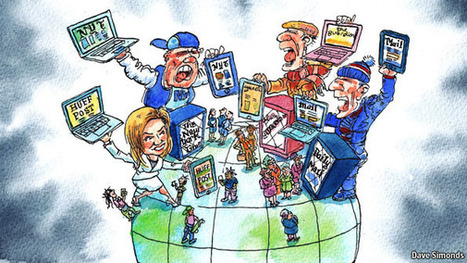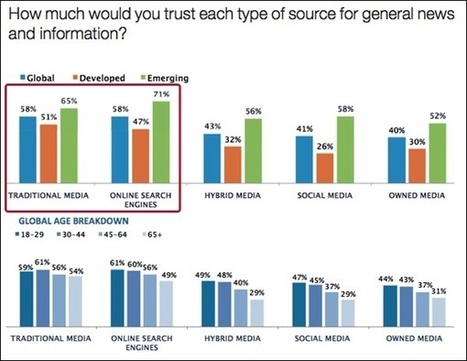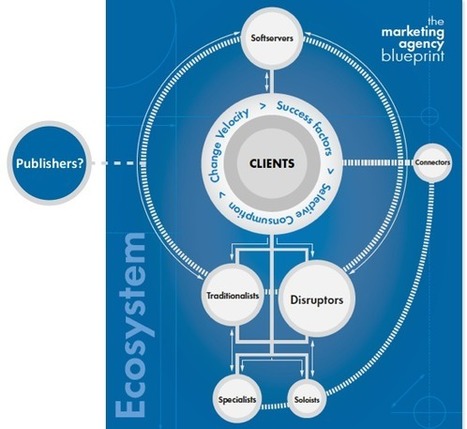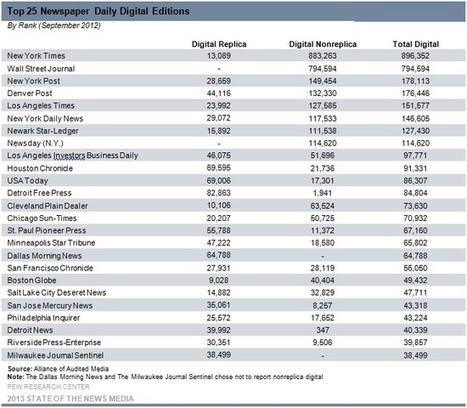 Your new post is loading...
 Your new post is loading...
About a year ago, NBC News established an account on Flipboard—the increasingly popular magazine-formatted, social mobile app—and has since grown its presence to a whopping 1.3 million monthly active readers. Starting today, the news org will be running its first third-party ads, purchased by old friend, General Electric; and NBC News says it is currently talking to other brands about buying in. "We have a lot of readers consuming our content on that platform," Peter Naylor, evp of digital sales for NBCUniversal, told Adweek. "When we looked at our monthly Flipboard users, we realized we had a pretty big opportunity. This is something we are going to study and see how readers go through it." Flipboard lets users aggregate Web and social media content, presenting the items in a magazine-like display on smartphones and tablets. With a swipe of a finger, users literally flip through content from the likes of NBC News and countless other publishing entities. Through September, GE will be running full-page interstitial ads within NBC News' Flipboard pages, which includes 25 new articles a day from NBCNews.com, Today.com and CNBC.com. When viewers click through GE's ads, they are driven to the multinational conglomerate's so-called magazine on the app—specifically to a section dedicated to innovation. These ads will effectively highlight the newest content from the GE magazine, using feeds from the brand's blogs, such as Txchnologist....
Or, put another way still, the paywall, other than providing a bit more time to wrestle with the underlining problems of newspapers, does not solve any of them. Even with this new class of free-spending readers, the economic problems remain exactly the same: • An extraordinary indifference, if not utter lack of interest, on the part of younger people to news brands and to news habits, a development that established news organizations have been unable to address, stall, or even fathom. • Dramatic abandonment of the medium by traditional advertisers, such that, since 2007, newspapers, according to industry monitor group Outsell, have seen more than a 40% decline in overall income, the overwhelming amount of that drop due to lost ad revenues....
Given the speed of the news cycle and the time needed video news production, social media is "the first way we break news now," says Andrew Springer, Producer of Social Integration at ABC News, in this interview with Beet.TV at SXSW.
The grizzled vet and the digital native: Journalism has plenty of room for both to succeed. I spent eight years at AOL and I'll say this: I saw none of the great, all of the bad and some of the good. ... The blood sport during my AOL days was about the future of media companies — who would or wouldn’t survive the digital onslaught. Actually, it was much the same during my time at Newsweek in the 80s (who needed three newsweeklies in a broadcast world). Ditto when I joined The New York Times in the 70s (was the city big enough for both The Post and Daily News). Now, the social Web with its echo chamber turns up the volume daily — and makes it more personal, too. It’s far more about the fate of the individual journalist. That quickly gets down to the paycheck. Will there be one? How much? Who gets it — the “professional” or the pretender? Consumer demand for credible news and information is greater than ever. The problem is the 100-year-old model for producing it is forever broken. That’s why more attention must be paid to finding new ways to produce quality journalism — efficiently, at scale and at a price supported by mobile CPMs, which at best are 50% lower than desktop CPMs, which if you’re lucky come in two-thirds lower than print CPMs. In other words, a high-cost newsroom structure built for the print age will never work in a smartphone or tablet world. A few startups are experimenting with new models — Vox Media, Machinima, Bleacher Report and Storify are a few that I follow. Among traditional media companies, FORBES is the only one I know of charting a new course....
IN JANUARY the New York Times lost its top spot in comScore's ranking of the world's biggest newspaper websites to Britain's Daily Mail. The Times sniffed at the accuracy of comScore's figures, which exaggerate the Mail's online audience by including a personal-finance site that the paper owns. But the battle to be biggest reflects a growing phenomenon: national news publications going global. A mere one-quarter of the Mail's online readers are in Britain. The Guardian, which caters to those who like their news left-leaning and serious in contrast to the Mail's right-wing raciness, has one-third in Britain and another third in America (see charts). Their chief competitors are two American publications: the New York Times, which like the Guardian aims at readers of serious news, and the Huffington Post, which since its launch in 2005 has become the biggest site of the four (it is not in comScore's “newspaper” category). That the HuffPo is beating papers with a history stretching back to the 19th century is a sign of just how differently news works online....
Striking the right balance on social media channels can be difficult enough, but what if your brand is behind a pay wall? The Drum chats to the Financial Times’s social media manager Rebecca Heptinstall and communities editor Sarah Laitner about why the brand is still with the times as it celebrates its 125th year.Is there a certain platform you prefer working on? Rebecca Heptinstall: Twitter is very much the Financial Times’s favoured social network in sheer community size (2.75m) and traffic to FT.com. That’s not to say that other social networks aren’t important, they certainly are – for example, we were the first newspaper to reach 1m followers on Google+ in July 2012. We’re also figuring out what platforms fit with the brand as and when they pop up – for us it’s less about being everywhere and more about being represented well in a few places....
When it comes to getting general news and information, consumers worldwide put as much trust in search engines as they do in traditional media — and more in both than they do in social media. But, the numbers don’t portray any single source as highly trusted, which suggests that consumers are at least trying to vet the accuracy and trustworthiness of what they find in today’s information-saturated world. The data comes from the recently released 2013 Edelman Trust Barometer, the 13th annual global survey that uses data from “informed publics” — college-educated individuals in upper income brackets that follow public policy issues and are active media users....
...As more people in any given newsroom are publishing to social platforms — andas more people bypass the homepage and instead use Twitter and Facebook as the entry point to any given news site — analytics companies see new opportunities to help media companies leverage real-time social data. Visual Revenue, a predictive analytics firm that focuses exclusively on media companies, is this morning rolling out a bundle of tools to help editors measure the effectiveness of social publishing in real time. “So, if you push a story right now on Nieman Lab, 40 clicks into it you might see 17 retweets, two favorites, some manual retweets and that’s all great, actually,” Visual Revenue CEO Dennis Mortensen told me. “But how do you really add all of it up?”...
Brands are becoming publishers, but do publishers have untapped opportunities as marketing agencies? ...Rather than viewing content marketing as their impending doom, publishers should be focused on the emerging opportunities: Create and distribute content, in and out of network.Produce sponsored content (aka native advertising).Tap existing advertising partnerships, and even consider cannibalizing their advertising business in favor of a more sustainable future.Offer integrated services (i.e. content + SEO + social + PR + email + analytics). Content alone isn’t enough. As Andrew Davis (@TPLdrew), author of Brandscaping, said in a recent Marketing Agency Insider post, “Publishers are masterful content creators, and they are able to charge a premium for the services they offer by leveraging theirmarket research, existing distribution platforms, and even the talent from their editorial teams.”
And Paul Rossi (@economistrossi), managing editor of The Economist, states on Digiday, "The opportunity for media companies is to create content that’s compelling for users on behalf of advertisers. That doesn’t mean it has to be native, but the skills in telling stories are quite valuable to marketers as they build audience themselves."...
When a helicopter crashed in a densely populated part of London around 8am today, next to one of the busiest trainlines in Europe and a large bus station, the news was always going to be broken, within seconds, by members of the public on Twitter, armed with camera phones.
Twitter user Craig Jenner was one of the first to put a picture on Twitter which was shared far and wide.
What happened next is indicative of the way the media are increasingly playing catch-up on such stories, moving from reporting to aggregating (or curating, if you must) - images, eye-witness accounts and videos. Journalists were asking to use the picture with a credit and were trying to get Jenner on the phone...
The arrival of the web knocked the news industry's relationships — with advertisers and with readers — out of alignment. But there are signs a few small repairs are working.... Misalignment grew, with readers and advertisers, as both themselves went increasingly digital. Think about it. In the old print world, advertisers paid up but really got a huge — and effective — audience, which moved goods and services. In this new digital world, they could buy online display that has never approached the results of print. Clickthrough rates tumbled toward the miniscule, tangible evidence of the growing disconnection. Shoppers found little usefulness in the advertising. Online advertising may have brought in a few billions, but publishers came nowhere close to creating the kind of local marketplace the newspaper had created. Cultural misalignment. Reader misalignment. Merchant misalignment. Shopper misalignment....
As the audience for Pinterest grows, so has journalists’ interest in it. News organizations are using the social networking site in creative ways and finding that it’s a place where both hard news stories and features can thrive.... [Great reminders and tips for PR, marketing too ~ Jeff]
"The new muckraking isn't the effect of new media alone...Yet buried within the infrastructures of communicative abundance are technical features that enable muckrakers to do their work of publicly scrutinising power, much more efficiently and effectively... Who or what drives the new muckraking? The temptations and abuses of power by oligarchs, certainly. The criminal obscenities, hypocrisies and political stupidities of those responsible for the deep crisis of parliamentary democracy in Greece and the wider Atlantic region, no doubt. The decline of parties and representative politics and strengthening democratic sensibilities against arbitrary power also play their part. But of critical importance is the advent of communicative abundance. Just as the old muckrakers took advantage of advertising-driven mass production and circulation of newspapers, so the new muckrakers are learning fast how to use digital networks for political ends....
|
...At their core, Facebook, Tumblr, and Twitter are sharing networks, not publishing companies. They act as platforms for other people’s content, which can be spread rapidly and massively among their communities. A consequence of being walled gardens that restricts this sharing activity within their own properties, however, is that they give up the right to decide when and how that content breaks free into the wider public discourse. Even though it had success with its partnerships program at placing stories into other forums, Storyboard’s stories always had the whiff of marketing, or what is these days being described as “native advertising.” As we now know, that ultimately did not work out for Tumblr. Going by Fletcher’s comments, perhaps Facebook Stories will meet a similar fate....
News publications having “sponsored content “deals are on the rise, and Google’s apparently concerned enough that it’s issued a warning today that publishers should keep such content out of Google News. In a post today on the Google News blog, the company writes: "If a site mixes news content with affiliate, promotional, advertorial, or marketing materials (for your company or another party), we strongly recommend that you separate non-news content on a different host or directory, block it from being crawled with robots.txt, or create a Google News Sitemap for your news articles only. Otherwise, if we learn of promotional content mixed with news content, we may exclude your entire publication from Google News." Why such a warning now? Consider this...
If the newspaper industry had theme music in 2013, it might use “Been down so long it looks like up to me,” the much-recycled line from a 1920s blues song. For the first time since the deep recession that began in 2007, newspaper organizations have grounds for a modicum of optimism... Companies have started to experiment in a big way with a variety of new revenue streams and major organizational changes. Some of the bright opportunities – such as offering social marketing services to local businesses – are ventures too new to be measured yet industry-wide. They show signs of stabilizing revenue.... Even halting improvement in the general economy helps the industry. The double whammy of cyclical ad losses on top of secular shift to new media has considerably eased from the worst of the recession from 2007 to 2010. Auto advertising has come back, and some markets, like Miami, are beginning to see recovery in real estate and employment ads as well. All those positives, however, are for the time being mostly promise rather than performance. The most basic indicators have not turned around. The industry is little more than half the size it once was. Considerable dangers persist... So the industry entered 2013 with some positive signs but still dealing with difficult economic realities. The two biggest newspaper developments of the last year – digital paywalls and reduced print frequency – capture that odd mix of expansion and contraction now typical within the industry....
One of the first things that crops up in conversation these days is the language of digital. The word content is over-used by marketers and publishers. The term does a disservice to the creative process behind it. I find it quite hard to think of stories as content – it’s so far removed from what it takes to do. In the digital age, journalism is still – just – clinging on by its fingernails and using the catch-all moniker of content is not helping its standing. Content covers all players, from finely honed pieces by professional journalists and commentators, to rants by amateurs. However, just because everyone now has access to a publishing platform online, doesn’t meant quality editorial is a dying art, nor does it mean that those producing quality editorial should ignore the changes happening in the publishing world. On a site like xoJane – to which I contributed to for a short stint – you’re trying to connect with people. You’re no longer handing down stone tablets for them to read. I think that’s a very important – and good – part of what’s happened to communication....
As more consumers access news on their mobile devices, news organizations are seeing traffic to their websites from desktop computers flatten or decline. And in some regions, such as many parts of Africa, users are leapfrogging the Web altogether and going straight to mobile. Although many newsroom leaders believe a "mobile, too" approach -- a focus on mobile in addition to other platforms -- will be enough, that mentality is shortsighted, Bergman said in a recent Poynter Online chat. Joining Bergman to discuss the news industry's transition to mobile were Poynter's Regina McCombs and Damon Kiesow, senior product manager for mobile at the Boston Globe and Boston.com. The chat included several helpful tips for newsrooms making the transition to mobile....
...For the past few years, we as an industry have been asking (often with great consternation): What is a digital magazine? All of the magazine titles I mentioned are answering this question differently. Some have created a news feed. Others, a video channel. Many repurpose their print articles into blog posts. The smart ones have created a searchable archive of past issues. A few just beg you to download their app. When we ask the question that way, we open the floodgates to all sorts of slop that is decidedly un-magazine. The typical guru’s answer involves heavy-handed social media. And push notifications. And monetizing your online channel by paginating just below the fold, capitalizing on viral lift, and recalibrating expectations to include a mix of advertorial content and strategically placed calls-to-action powered by a new algorithm to maximize synergistic opportunities.
Gross....
Tech site develops predictive platform to monetize traffic surges In an analytics-obsessed Web climate, everyone is chasing the big story. The problem is, more often than not, big breakout traffic scoops yield attention, eyeballs and notoriety, but very few dollars. Last month, Deadspin broke the story on the Manti Te’o girlfriend hoax, netting the site nearly 4 million pageviews. But as Gawker Media mentioned publicly following the story, the company had no technical solution in place to monetize an unforeseen surge in traffic. Gawker is not alone. Web publishers have struggled across the board with this, which is why Ars Technica has been hard at work with what could be a viable solution. At Ars Technica, Condé Nast’s 15-year-old high-brow tech site, Ken Fisher and his small in-house team were lamenting the traffic conundrum when they decided to build a real-time dashboard geared toward examining pageviews with a predictive eye toward recently posted articles that are poised to trend. "Within two days we found it was working really well," explained Ars editor in chief Fisher. “We were identifying within an hour stories that would go on to do 900,000 views. And these were not pieces you’d hear by title and think, ‘That’s going to be killer.’ One was titled, Quantum Networks May Be More Realistic Than We Thought.”...
"Internet Users Demand Less Interactivity," read the headline of a recent article at The Onion. A (fictional) Internet user commented: "Every time I type a web address into my browser, I don't need to be taken to a fully immersive, cross-platform, interactive viewing experience...I don't want to take a moment to provide my feedback, open a free account, become part of a growing online community, or see what related links are available at various content partners." Are magazine app users starting to feel the same way? Faced with floods of online content, readers open magazine apps for a cohesive, relaxed reading experience -- only to cope with massive file downloads and confusing, complex interfaces.
A new batch of magazine publishers wants to move in a different direction. Drawing on the concept of "subcompact publishing," recently articulated by Craig Mod, and often mentioning Marco Arment's The Magazine as inspiration, these publishers are creating minimalist magazine apps that do just enough -- and no more -- to provide a focused, deep, quality reading experience....
...Ad-supported journalism is being consumed in record quantities, but those of us who manage media companies face a stark reality: Traditional advertising dollars in print and broadcast become dimes on the full-scale web, and they tend to disappear entirely on mobile devices. Alternative revenue models, then, are key to success, but only if they follow ethics guidelines that protect media outlets from losing credibility with readers. Sponsored content, as it is now being published on the full-scale and mobile web, differs from old-fashioned print advertorial in significant ways. The biggest departure is that, rather than passively receiving and publishing advertorial copy from ad agencies, media outlets are more often partnering with brands to create custom-content “native advertising” campaigns that resonate with readers who fit the publication’s demographic profile. BuzzFeed, for instance, employs a large staff to craft brand-marketing pieces that readers will share with friends via Facebook and other social networks. One such recent post, “11 Things No One Wants To See You Instagram,” quickly drew 330,000 views on behalf of advertiser Virgin Mobile, the Wall Street Journal reported. Similarly, Forbes Media created a Forbes BrandVoice program through which brands can submit paid articles to the Forbes website. “The advertiser-sponsored copy appears in the same style and format as articles contributed by Forbes writers and editors,” New York Post media columnist Keith J. Kelly reported in November. (The BrandVoice connection is noted at the top of posts.) This is a Wild West moment for sponsored content...
The immersive multimedia documentary, built using Zeega, tells the story of the impact of oil drilling in North Dakota. Todd Melby wants to tell small stories. Hardly an impossible goal for a journalist, but when you’re looking at something as big as the explosion in oil drilling in North Dakota, the scale of the story can get out of hand. In less than five years, the state has tripled its oil production; the Census Bureau estimates western North Dakota (where the oil is) will see its population increase by 50 percent. Big story. So Melby decided to to tell the macro story in a micro way, focusing on the roughnecks who come to North Dakota in search of jobs, the daily experience of working on an drilling rig, and the families whose lives are upended by the oil patch. The result is Rough Ride, a multimedia experience that takes an intimate, documentary-esque approach to telling the story. Split into a series of chapters, Rough Ride divides up the various players and scenes found throughout North Dakota’s rapidly expanding oil country, intertwined with interactive graphics, photography, and first-person video. (It’s not something easy to embed in an article like this; you really do need to go to the site and let it play to get the experience. Go full screen if you can. It’s immersive in a way that a 600-pixel-wide frame can’t be.)...
...Take Twitter for example. A wonderful way in which friends can talk to friends and friends of friends who are on the spot. But, if one has a look at who has large followings, a lot of journalists are right there. In almost every case, journalists who have the largest followers are those who are not only on the ball and on the spot but who have in successive 140 character messages been able to succinctly and accurately move information to their followers. Generally speaking, journalism needs to up its game. Professional hacks need to be able to place themselves on a much higher plane than so-called citizen journalists and bloggers. What they write and say has to be structured in a way that oozes professionalism and integrity, relevance and credibility....
The blog is dead.I don't say it lightly; I've been blogging since 2000, moving from an email list I started in the '90s to Blogger to TypePad to Wordpress.com to Wordpress.org. ...So I see that moving my blog around like this is just staving off the inevitable; we are moving to collections and curations, to mobile content, and to different authoring tools. Think for a moment about the incredible popularity of Tumblr, or of Pinterest. I believe they are early iterations of the content revolution. I told my journalism students, who are just being taught by their professors that the new way is "digital first," that they have to stretch again--this time all the way to "mobile first."... [Francine Hardaway's provocative Fast Company article is a MUST-READ for every current and future blogger, PR and content pro! She really captures "what's next."~ Jeff]
Via Angela Nibbs
|



 Your new post is loading...
Your new post is loading...

































How NBC is monetizing its Flipboard magazine.